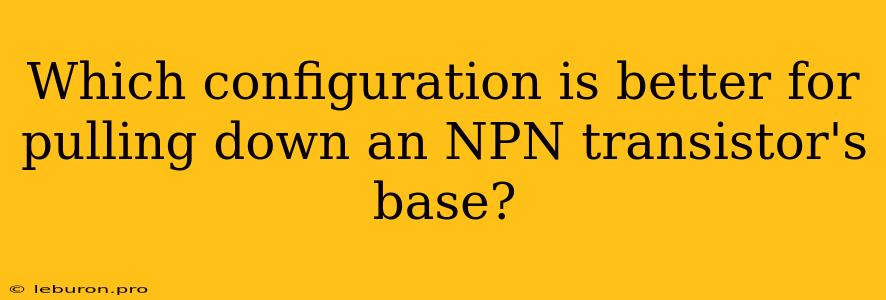Understanding Transistor Configurations for Base Pull-Down
Transistors, particularly NPN transistors, are fundamental components in electronics, acting as electronic switches or amplifiers. One crucial aspect of transistor operation is controlling the base current, which in turn influences the collector current. Pulling down the base of an NPN transistor refers to reducing its base voltage, effectively turning the transistor off. This article delves into the different configurations used for pulling down the base of an NPN transistor, comparing their effectiveness and highlighting considerations for choosing the right configuration for your application.
Pull-Down Resistors: The Foundation of Base Control
The simplest and most common method for pulling down the base of an NPN transistor is using a pull-down resistor. This resistor is connected between the base of the transistor and ground, ensuring that the base voltage is pulled towards ground when the transistor is not actively driven by an external signal. This is crucial for preventing the transistor from accidentally turning on due to stray voltages or noise.
Understanding the Pull-Down Resistor's Role
The pull-down resistor's value significantly influences the transistor's behavior. A lower resistance value ensures a faster pull-down, leading to quicker switching times. However, a lower resistance also draws more current when the transistor is off, potentially impacting power consumption. Conversely, a higher resistance value results in slower pull-down but reduces the quiescent current draw.
Choosing the Right Pull-Down Resistor Value
The ideal pull-down resistor value depends on the specific application, considering factors like:
- Transistor Characteristics: The transistor's base current (IB) and beta (hFE) values directly influence the pull-down resistor's value. A higher base current requires a lower resistor value.
- Switching Speed: If rapid switching is critical, a lower pull-down resistance is preferred.
- Power Consumption: Minimizing power consumption demands a higher resistor value.
- External Circuitry: The load connected to the transistor's collector and the driving signal's characteristics also play a role in determining the appropriate pull-down resistor value.
Example:
Suppose an NPN transistor with a base current (IB) of 1 mA and a beta (hFE) of 100 is used. For a collector current (IC) of 100 mA, the base current needs to be 1 mA. To achieve this with a 5V supply, a pull-down resistor of approximately 4.7 kΩ can be used.
Active Pull-Down: Enhanced Control and Speed
While a pull-down resistor provides basic base control, active pull-down circuits offer greater flexibility and faster switching times. This approach typically uses another transistor (typically an NPN or a MOSFET) to actively pull the base of the main transistor towards ground.
Understanding Active Pull-Down Circuits
Active pull-down circuits employ a separate transistor as a switching element. This transistor is controlled by an external signal, allowing for precise control over the pull-down process. When the control signal is high, the pull-down transistor conducts, quickly bringing the base of the main transistor towards ground. When the control signal is low, the pull-down transistor is off, allowing the base to be driven high by an external signal.
Advantages of Active Pull-Down:
- Faster Switching: Active pull-down circuits offer faster switching times due to the active control of the pull-down transistor.
- Precise Control: The control signal allows for fine-grained control over the pull-down process.
- Improved Performance: Active pull-down circuits can improve the performance of the overall circuit by reducing switching delays and noise.
Example:
An NPN transistor (Q2) can be used as an active pull-down for the base of another NPN transistor (Q1). When the control signal is high, Q2 turns on, pulling the base of Q1 low. When the control signal is low, Q2 turns off, allowing the base of Q1 to be driven high by an external signal.
Choosing the Best Configuration: Factors to Consider
The choice between a pull-down resistor and an active pull-down circuit depends on the specific application's requirements:
- Complexity: Pull-down resistors are simpler to implement, while active pull-down circuits involve additional components.
- Switching Speed: Active pull-down circuits offer faster switching times.
- Control: Active pull-down circuits provide greater control over the pull-down process.
- Power Consumption: Pull-down resistors generally consume less power than active pull-down circuits.
For applications requiring fast switching speeds and precise control over the pull-down process, active pull-down circuits are the preferred choice. On the other hand, pull-down resistors are suitable for simpler applications where speed and control are not paramount.
Conclusion
Understanding how to effectively pull down the base of an NPN transistor is crucial for designing and implementing various electronic circuits. Both pull-down resistors and active pull-down circuits offer different advantages and disadvantages, and the best configuration depends on the specific application's requirements. By carefully considering the factors discussed above, you can choose the most appropriate pull-down configuration for your design, ensuring optimal transistor operation and overall circuit performance.
